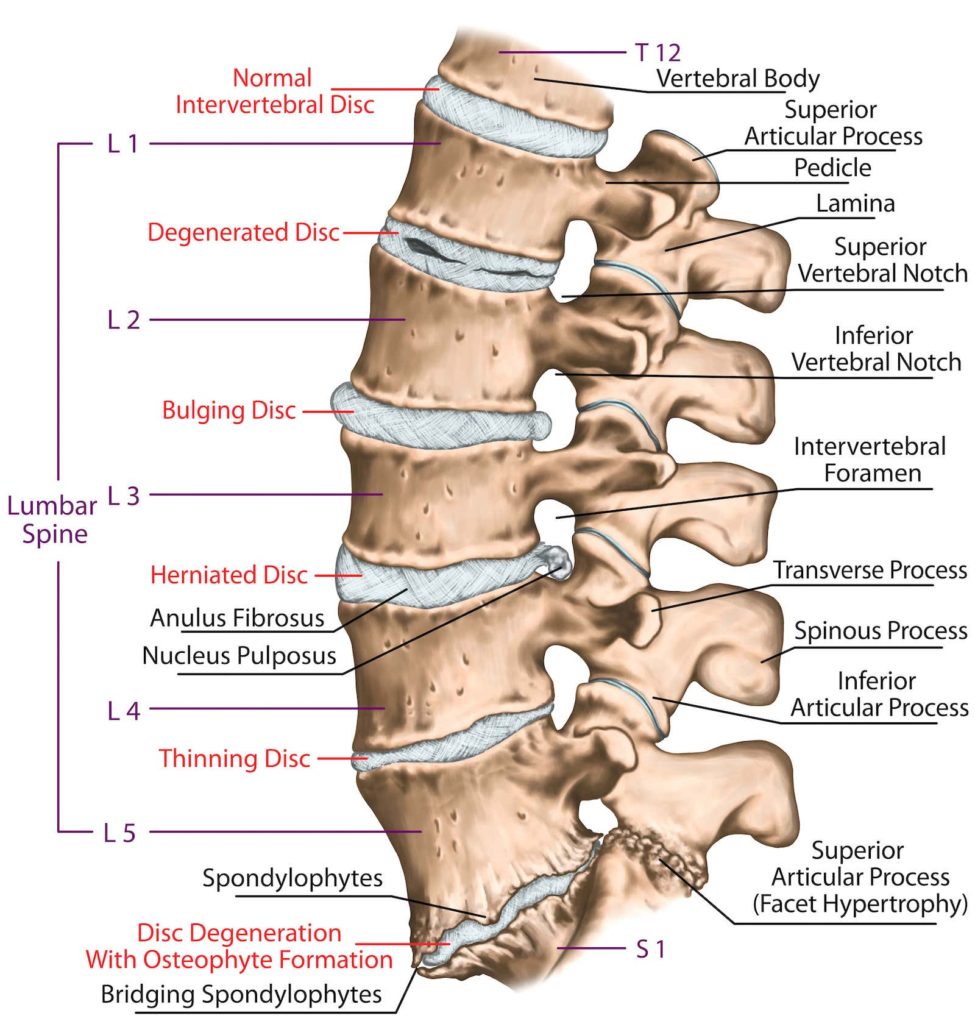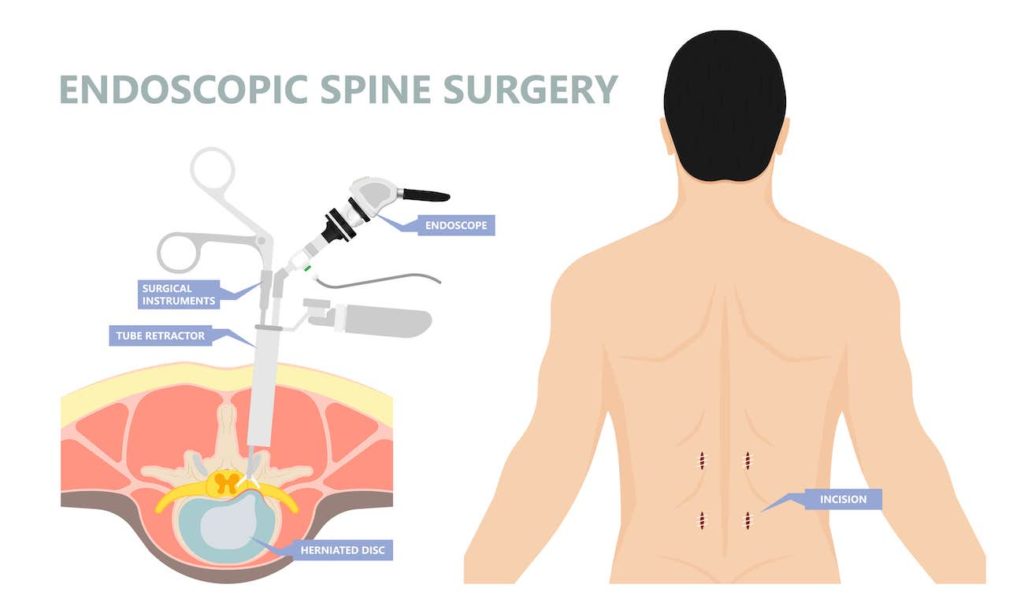Has this article been insightful? Share it!
Degenerative spine disorders, as the name implies, are often caused by daily activities that stress and strain the spine. The spine is a supporting structure in the body that extends from the skull base to the tailbone. It functions as the backbone and the central support structure of your body. The spinal cord, the main neural pathway from the brain to the whole body, is present in the spinal canal and is surrounded by cerebrospinal fluid. The cerebrospinal fluid serves as a cushion that protects the nerve roots and spinal cord from injury during activities such as sitting, bending, and twisting.
Depending on your activities, posture, movement and level of stress and strain, the spine – especially the vertebral bone, ligaments, and joints – gradually loses its natural alignment, structure and function. Aside from ageing, health issues, including tumours, infections, trauma, or arthritis, will speed up the degenerative process in the spine, leading to more serious conditions such as degenerative disc disease. Degenerative spine disorders are not an uncommon condition among the elderly. As you age, the consistency and flexibility of your spine deteriorate, increasing the risk of developing degenerative spine disorders, which can limit your movement and interfere with your ability to do daily tasks.
Some common degenerative spine disorders include:
Cervical and lumbar spondylitis
Herniated discs or slipped discs with sciatica
Spinal stenosis
Facet joint arthritis, etc
Degenerative spine disorders are classified depending on the location of the affected spine (cervical, thoracic, lumbar, and sacrum).

Spinal nerve root entrapment is typically associated with degenerative spine disorders. There are some reactive changes within the spinal canal and the nerve root openings that pinch or press the spinal cord and nerve roots. The initial phase of irritation and compression can lead to severe nerve root pain and significant muscle spasms in the affected nerve root area. Eventually, patients may experience numbness if the compression is severe enough to cause spinal cord or nerve damage. Usually, it involves:
This condition is caused by a compression in the cervical area of the neckbone. Patients generally experience severe pain in the neck that radiates towards the arm, shoulders, and upper portion of the back (the area in between the two shoulder blades).
Some patients complain of very unpleasant feelings and not knowing how to position their heads at night, making it difficult to sleep.
As the spine is a mobile axial bone in the body, the process causing spinal instability is not entirely clear. The stability of the spine during its movements, whether it is bending or twisting, is determined by the,
They serve as the primary support elements in the spine.
Any injury or disease that affects these elements can cause spinal instability, which can eventually lead to compression of the spinal cord or spinal nerve roots at the affected level. Therefore, spinal instability is often associated with spinal degeneration changes (age-related changes) and injuries (muscular). These progressive changes can be triggered by:
The most common symptoms of cervical spine disorders are neck and shoulder aches, followed by arm pain, numbness, or electric shock-like sensations in the arms and fingers. They are mainly caused by ageing, trauma (whiplash injury), and daily stress and strain from abnormal head and neck postures.
Nowadays, abnormal head and neck postures with early degenerative changes in the cervical spine are commonly diagnosed in youngsters, people who use their smartphones excessively, employees with desk jobs, and highway or taxi drivers who travel long-distance.
The cervical spine associated with disc herniation or spinal cord compression is the most severe condition that requires prompt decompression and proper treatment. If left untreated, it may result in severe nerve root or spinal cord damage, leading to total paralysis and permanent disability. The cervical spine disorders are:
When the outer fibrous membrane of the spinal disc ruptures, the nucleus pulposus – a soft, gelatinous material – protrudes, resulting in a lumbar prolapsed disc. The extruded disc material presses or irritates the surrounding nerve roots, causing inflammation and stimulation along the nerve fibres.
It is characterised by severe back and radicular pain in the legs, usually accompanied by numbness and paraesthesia. Pain limits the mobility of the affected limb, which can worsen and lead to paralysis of the affected nerve (similar to limping gait in patients with stroke).
Degenerative spine disorders are high-risk disorders. If left untreated, they can lead to paralysis of the affected limb. Schedule an appointment with your neurosurgeon whenever you have the following symptoms.
Following a diagnosis, prompt treatment through pain management or minimally invasive surgeries is required.
● Ageing
● Trauma
● Sport injury
● Inflammation (arthritis)
● Scoliosis (abnormal spine alignment: either congenital or degenerative)
● Infection
● Tumours (primary or secondary)
● Inactivity (bed-bound/wheelchair-bound due to stroke/ trauma)
● Congenital or acquired neuromuscular disorders (multiple sclerosis)
● Endocrine disorders affecting bone
● Congenital/ genetic disorder affecting the axial spine (ankylosis spondylitis)
● Smoking
● Obesity
An important step of the diagnostic process involves getting a detailed history of your symptoms, lifestyle, and personal and family history. After this, your doctor would conduct a general physical exam, neurologic assessments, and other diagnostic tests.

In order to accurately diagnose your disorder, certain tests are performed, such as:
A powerful magnetic field and radio waves are used to provide a clearer image of the affected area and the nerves involved.
A CT scan is used to better visualise the vertebrae (bones of the spine) as well as other spinal structures and tissues to provide more information on the spine’s structure and spinal tissue.
Full-body 3D images of the spine are used to examine its alignment. These images are taken with the patient in a natural, standing position. An EOS scan emits much less radiation compared to CT scans and X-rays.
Low-dose X-rays are used to measure bone density and the mineral content of the bones.
Dynamic X-rays reveal structural instability of the spine during movement.
Urodynamic studies are a series of tests that help assess the bladder and its sphincter function in relation to the spinal cord and nerve roots.
This helps diagnose nerve roots and peripheral nerves together with their supplied muscle groups by measuring the electrical activity and sensitivity of the muscles and nerves.
Treatment of degenerative spine disorders depends upon the type and severity of the disease, the extent of nerve root involvement, and stability of the spine.
Basically, not all degenerative spine conditions require open or minimally invasive surgery. Proper assessment and evaluation are the main steps for the initiation of treatment. Non-surgical options for treatment include:
Minimally Invasive Spine Surgery (MISS) is a type of procedure that involves operating on the bones of your spine. It requires smaller incisions than conventional surgery and typically causes less damage to surrounding muscles and other tissues. It can also reduce pain and speed up recovery from the procedure. During minimally invasive surgery, the doctor creates one or more tiny incisions and inserts a device known as a tubular retractor, a stiff, tube-shaped tool. It forms a tunnel to the affected area of the spine and gently moves the muscle and soft tissue surrounding the area. The surgeon can then insert small instruments via the tunnel to operate on the spine.
The surgeon also employs a specialised operating microscope, high-resolution cameras, computer-assisted robotic guidance and real-time X-rays of the spine. Minimally invasive spine surgeries can be used for certain types of spine treatment procedures, including lumbar spine surgeries, endoscopic procedures, and spinal fusion with metal rods and screws.
A discectomy is performed to remove the herniated disc, relieving pressure on the nerve root or spinal cord. Often, it is carried out via a minimally invasive surgery, called an MIS microdiscectomy, in which small incisions with a narrow space are made under a microscope or endoscope and the disc placing pressure on the nerve or spinal cord is removed.
It is a very short procedure with less damage to the surrounding tissues and minimal pain at the operative site. The patient can ambulate immediately after the procedure and may go home on the same day or stay overnight in the hospital.
This is a surgical procedure that creates more space for the nerve roots at their exits or spinal cord. It relieves pressure resulting from thick ligaments or bony spurs formed due to spinal degeneration.
Decompression can minimise spinal canal pressure and enhance spinal blood circulation, reducing inflammation and congestion in the spinal cord. This, in turn, relieves pain in the lower area of the spine and along the nerve roots in the legs.
This is a post-decompression surgical procedure in which specific metal implants (screws or rods with artificial discs) are inserted to reinforce the stability of the affected spinal area. The stability of the spine is critical for proper spine alignment and subsequent early mobilisation of patients after surgery.
Degenerative spinal nerve disorders are the most common age-related ailment causing nerve pain and numbness in the affected areas. They are associated with the loss of spinal alignment, which results in more damage to the nerve roots and spinal cords when handling heavy objects, walking, bending, and twisting.
As spinal nerve disorders can lead to permanent damage and paralysis of the affected limb, it is crucial to diagnose and treat them as early as possible. Whether you require pain management procedures or minimally invasive surgery in Singapore, schedule an appointment with us today for personalised treatment.

Senior Consultant
Neuro & Spine Surgeon
MBBS, MSc Surgery, MRCS (Edin),
MMed. Sc (Gen Surg) (S'pore),
FRCS. Surgical Neurology (UK)
Dr Sein Lwin is an experienced Senior Consultant Neuro & Spine Surgeon and the Neurosurgical Director at the Advanced Brain and Spine Surgical Centre.
He is highly experienced in spine surgery and in minimally invasive approaches for spinal cord tumours and degenerative spine surgery. His specialised interests lie in endoscopic endonasal and open skull base surgery, pituitary tumours, vascular surgery, cranial nerve disorders and peripheral nerve conditions.
Many neurological conditions may require urgent attention. If you require immediate care, please contact us.
Contact Us For More Information
We provide quality specialised care for neuro and spine conditions.
For enquiries, leave a message and our friendly team will get in touch with you.
Monday – Friday: 9:00AM – 5:00PM
Saturday: 9:00AM – 12:30PM
Sunday & Public Holiday: Closed
We provide quality specialised care for neuro and spine conditions.
For enquiries, leave a message and our friendly team will get in touch with you.
Monday – Friday: 9:00AM – 5:00PM
Saturday: 9:00AM – 12:30PM
Sunday & Public Holiday: Closed
We provide quality specialised care for neuro and spine conditions.
For enquiries, leave a message and our friendly team will get in
touch with you.
Monday – Friday: 9AM – 1PM | 2PM – 5PM
Weekends & Public Holidays: CLOSED
© 2023 All Rights Reserved | Advanced Brain & Spine Surgical Centre | Terms & Conditions